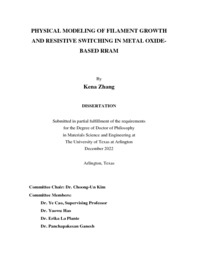| dc.description.abstract | Metal oxide-based resistive random-access memories (RRAM) exhibit several excellent performances, such as nanosecond switching speed, large write-erase endurance, and long retention time, and can potentially replace the traditional circuit elements for use as the fundamental units in next-generation hardware deep-learning or neuromorphic systems. The functionality of a metal oxide-based RRAM is attributed to an oxygen vacancy (V_O^(..))-rich conductive filament (CF), which initially forms, and later dissolves or regrows inside the oxide layer during the resistive switching process. However, the complicated interplays among the coexisting chemical, electrical, mechanical, and thermal effects during the formation, growth, and rupture of the CFs make the dynamic of the resistive switching behavior extremely complicated and unpredictable, and its underlying mechanisms are not fully understood. Here, we developed a phase-field model based on defect chemistry, charge transport dynamics, and micro elasticity theory to investigate the electroforming process and subsequent resistive switching behavior, using HfO2-x as a prototypical model system. It is revealed that the CF formation is assisted by the supply of oxygen vacancies V_O^(..) at the anode/oxide interface and the V_O^(..) transport in the bulk during the electroforming process. The CFs with more uniform morphology can be obtained by employing active electrodes with low vacancy formation barrier Eb and metal oxide with large electrical conductivity and lower thermal conductivity.
We also explored the role of the elastic effect on resistive switching behavior. It is found that the local oxygen vacancy distribution induces a local Vegard strain and a strain gradient, which acts as an additional driving force that inhibits the oxygen vacancy migration during switching and reduces the current on/off ratios. In addition, high-throughput phase-field simulations and a machine learning approach are performed to derive interpretable analytical correlations between the material properties (electrical and thermal conductivities, Vegard strain coefficients of the metal oxides) and the device performances (current on/off ratio and switching time). It is revealed that optimal resistive performance can be achieved in materials with a small Lorenz number and Vegard strain coefficient.
Furthermore, we also found that the switching performances can be enhanced by microstructure design. Due to the electric field concentration effect, embedding metal NIs leads to a more deterministic formation of the CF from their vicinity, in contrast to the random growth of CFs without embedded NIs. This deterministic vacancy nucleation further reduces the forming, reset, and set voltages, and enhances the uniformity of these operation voltages and current ON/OFF ratios. We further demonstrate that increasing the height of NIs, modifying the metal NIs to a triangle shape, and choosing active NI metals with high oxygen affinity can further optimize the switching performance. Our work provides a deep understanding of the underlying mechanism of CF growth and rupture, as well as the designing strategy for materials selection and microstructure design for further improved RRAM performances. | |


